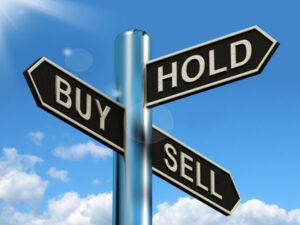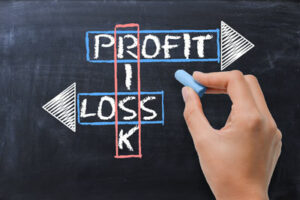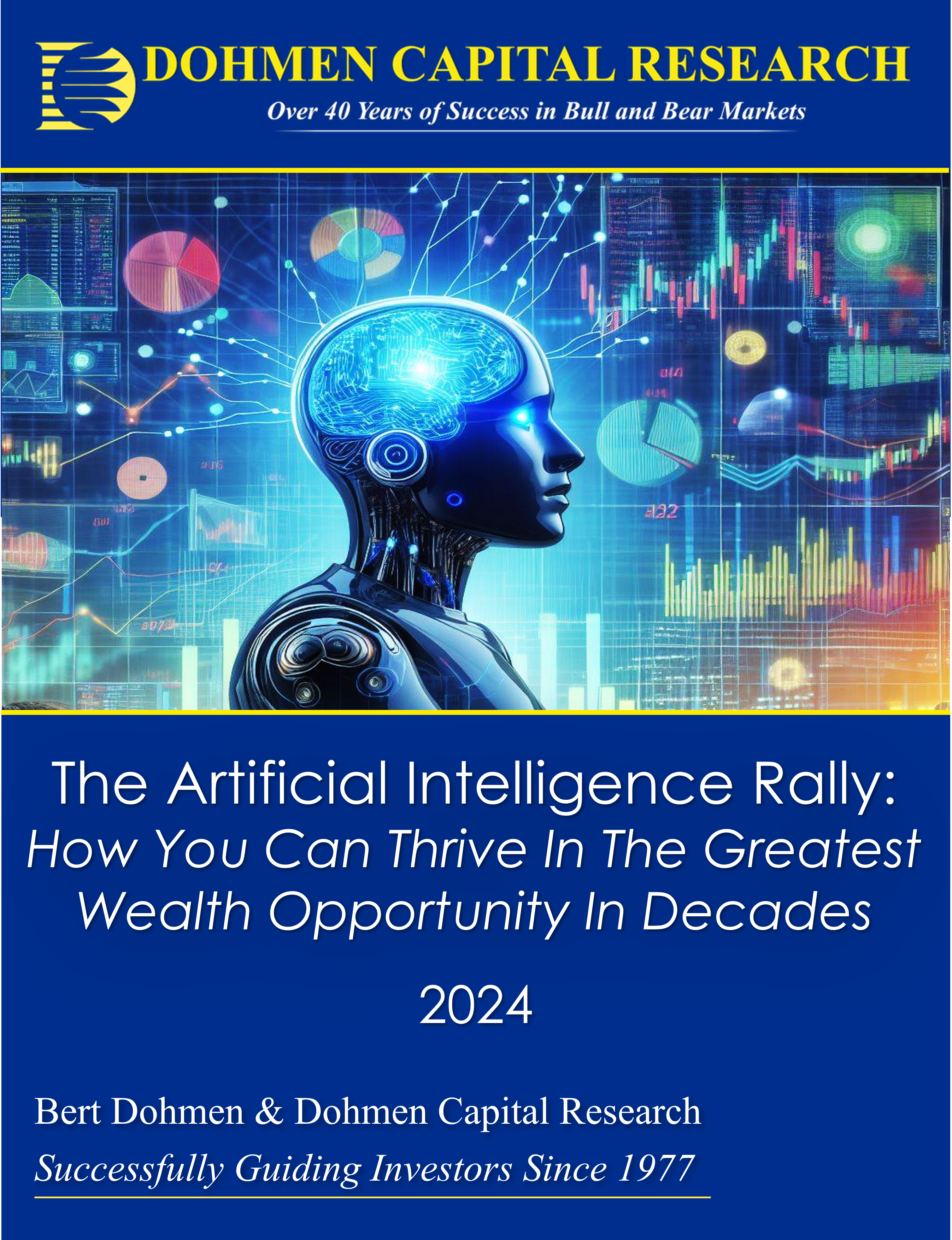Investment Strategy
“Buy and Hold” is Dead: Long Live Active Investing!

Wall Street always preaches the “buy and hold forever” approach to investing. And then the cite the very successful investor, Warren Buffett. Well, Buffett doesn’t hold most stocks forever. If you look at his record over the past 42 years or so, you will see that at a market top, he usually has accumulated huge amounts of undeployed cash.
That’s how he was able to bail out Goldman Sachs, General Electric, and Bank of America. Imagine, during the last crisis these huge firms could only get capital from Buffet. And of course, he struck very favorable deals that no other investor ever could have gotten.
At a market bottom, when the proverbial “blood is running in the street,” he is one of the few who have significant cash to invest. We would call that “market timing.” And that’s what we practice.
If you are an active investor, or trader, Bert will show you how to catch the important turns in the markets and sectors. Don’t fall for that ruinous “buy and hold forever” advice. It’s the road to financial disaster and the poor house.
From the year 2000 to 2012, the S&P 500 index actually showed a loss. Imagine, 12 years without any gain. You would have done better with your money in short-term T-bills without any risk whatsoever. That’s why money managers now say that they have “a 10-20 year time horizon” instead their typical “5-10 year” investment horizon which turned out to be a loss.
It’s a fact that when Wall Street analysts are most bullish on the market, it’s time to sell. In early year 2000, Wall Street told investors that new technology had fostered a ‘new era of prosperity.’ It was nonsense… and the stocks collapsed over the next three years. Many of the high-flying stocks declined 90%, and others totally disappeared, such as Commerce One, which soared from $2.50 per share to $997 (almost $1000) and then collapsed to zero.
That bear market wiped out over $9 TRILLION of investor wealth. It lasted 2 years, 7 months.
In 2008 we heard the Wall Street “experts” saying that “it’s time to buy” because the “average” bear market only last 11 months. We wrote that this statement “was absurd.” The near-meltdown a few months later proved it. Obviously such “free” advice is worth what you pay.
No Investment is “Forever”

To be successful, an investor must “time the market.” Wall Street tries to tell you that no one can. But that’s just because they don’t want YOU to try.
At the bottom in October 2002, gloom and doom prevailed. But our indicators showed that stocks were being accumulated by the big, smart money. We gave a “BUY” signal, and pinpointed the turn again.
You see, it’s important to have an advisor who can catch the turns, and turn from bearish to bullish and back again at the right time. You don’t even have to catch the day of the turn, although we have on many important occasions, like the 2000 top, the critical 2007 top, and the March 6, 2009 bottom of the crash.
At the top of the 5 year bull market in 2007, the top Wall Street CEO’s and heads of the largest private equity firms said (at a major conference in Beverly Hills) that “we have never seen conditions this good.” That was the ultimate “sell” signal for Bert Dohmen.
To Be Successful in the Markets, You Must Be Able to Catch the Turns
There are plenty of “Perma-bulls” who do well during bull markets, and “Perma-bears” who do well in bear markets. But they will always lose you lots of money when the major trend changes against them.
The key is to have a sophisticated strategy for catching the major turns. And over the last 41 years, no one has done that better than Bert Dohmen. (In fact, we challenge any investment professional to produce a better precision record).
Our clients prospered during the bull market from 2002 to 2007. But then Bert Dohmen saw the first warning signs. In January 2007, Wall Street, the Federal Reserve chairman, and the vast majority of advisors told investors that all was well. The Fed chairman said that the subprime mortgage problem was “too small to infect other markets,” and that the strong global economies assured prosperity in the U.S.
Bert Dohmen strongly disagreed. He communicated to clients that the gigantic global credit bubble was about to pop. He said that the bull market in stocks would end later in 2007, and that a global financial crisis similar to the 1930’s was likely the following year. It was the first time ever for him to see such gloomy prospects.
Once again, he was right on target. The Dow Jones Industrials made a major top on October 11, 2007. That top was identified by Bert a few days later in the October 15 issue of the WELLINGTON LETTER, which was headlined, TOP OF THE RALLY. A subheading was: “The Eye of the Hurricane.”

Yes, once again he called the bull market top within a few days. That’s the kind of precision, subscribers of Bert’s advisory services have become accustomed to. And now you too can get the same benefit of his experience.
But there were many skeptics about the prediction of a threatening meltdown of the global financial system. Economists were talking about the “Goldilocks” economy, i.e. that it was the best of all worlds. Bert replied, “at an important top, things always look like they can’t get any better. And they can’t. That’s what makes the top.”
He warned that we had seen “the greatest credit bubble ever created by mankind. The implosion of that bubble will lead to the opposite extreme, and no man, government, central bank, or all of them combined will be intelligent enough to prevent that calamity.”
Our advice to subscribers has been that in the current, crisis-prone environment worldwide, there is no such thing as a “long-term hold.” If you want to reduce your risk, while enhancing your profits, you must be an active investor or a trader.
That’s how the major Wall Street firms make most of their profits… trading their own money. You can’t just buy a stock or ETF and go away. And there is no sense having good profits, and then just let them vanish.
Example: One of the best investors in the world, Carl Icahn, in late 2012 bought a large position in NETFLIX when Wall Street was bearish on the company. In October 2013, he sold much of it. His profit: $825 million, in one year! And he still owned 4.5% of the company stock thereafter. He still likes the company, but he took big money off of the table.
He sold on the day Netflix reported great earnings and naïve money managers piled into the stock. At the end of the day, NETFLIX had declined over $67 from the high of that day ($389). Icahn smiled all the way to the bank. It’s called “selling on the news.” (Bert had recommended the stock 10 years ago at $23.)

During the near-meltdowns of 2008, where the largest Wall Street and financial firms such as Lehman Bros., Bear Stearns, Washington Mutual went out of business, subscribers to Bert Dohmen’s advisory services made big profits. (Look at the “Track Record” section of our website). While almost all investors were panicking, our clients had the chance to make incredible profits using the inverse ETFs.
Bert Dohmen has always loved bear markets. In a bull market, even a chimpanzee with a dart board can make money. But few traders and analysts make money in bear markets. Their mind set is that stocks have to rise to make a profit.
That separates the amateurs from those who really know what they’re doing. Stocks decline faster than they rise. Therefore, you can make greater profits faster in bear markets, if you have the best timing advice in the business.
Bert Dohmen’s experience of more than four decades trading the markets, using sophisticated technical analysis in combination with an astute analysis of the credit markets, can be your guide on a continuing basis. It’s like going to war with the most experienced platoon leader, rather than a rookie.
Advanced technical analysis measures the flow of money into and out of the investment markets, or a stock, on a continuing basis, and different time intervals. With the power of today’s computers, it’s possible to scan thousands of charts in a flash. And that power can work for YOU with our help.
The Hype In Performance Numbers
Furthermore, we saw that some other advisory services advertised “unbelievable” gains of 100% and 200% and more, totally unsupported by any credible evidence. As the saying goes, if something sounds too good to be true, it probably is. We chose not to compete with such outlandish claims.
For those who ask for performance numbers, we say, ‘How do you know if any numbers given to you over the phone or marketing hype are true?’ After all, even Bernie Madoff was audited yearly by several regulatory bodies. Yet all his reports were fraudulent.
Therefore, we decided to no longer publish these examples. We are proud of our clientele of serious traders and professional money managers. We say, “Try it for a month or two. That’s the best way to know if it is for you.”

Trading is a profession. Doctors, dentists, CPA’s, attorneys, all take years and years to study and practice to learn their skills. Successful trading is no different. It is not “playing the markets”, or “dabbling”. It is serious business… and it can make you wealthy if you are willing to commit the time.
So, if you believe some of the outrageous claims made by other subscription services, go ahead. However, if you would rather follow the analysis and advice of a long-time professional try our advisory services.
No hype, no false claims, no bias, and no conflict of interest!
Unbiased Advice
Best to avoid all that and get your advice from an unbiased source. Bert Dohmen can call it the way he sees it. He has no axe to grind. And his clients can attest to the excellent results.
However, Bert Dohmen would be the first to caution that he does not have a crystal ball, and not all recommendations make big profits.
Risk control is most important, and that is what we do. Professional traders have profits on only 25-35 % of their trades. Yet, they make millions in profits every year. The key: “Never let a small loss turn into a large one. Take small losses quickly and let profits run.”

The only way you can know if our advisory services are for you is by trying them. That doesn’t mean a “free”, two week trial which many other companies offer today. That won’t tell you a thing, except that your e-mail is working.
Consider a subscription to any of our advisory services as an investment in your future. You pay for a college education (no guarantee’s or free trials there), for professional seminars, buy books, and study on your own, all to get ahead of the pack.
We don’t offer “free” trials. A good lawyer doesn’t handle your lawsuit as a “free trial,” and the CPA doesn’t give you a free tax return. There are no “free-bees” in things of real value.
We Deliver What We Promise
Bert Dohmen is known as a contrarian. His interpretation of events is often totally contrary to accepted “wisdom.” He says, “what everyone knows is not worth knowing.” In other words, it has already been acted on in the markets. And most important, don’t postpone your decision. Procrastination is one thing that doesn’t work in the markets. Make your decision today and ask yourself, “Do you really want to get serious about your investments?”


